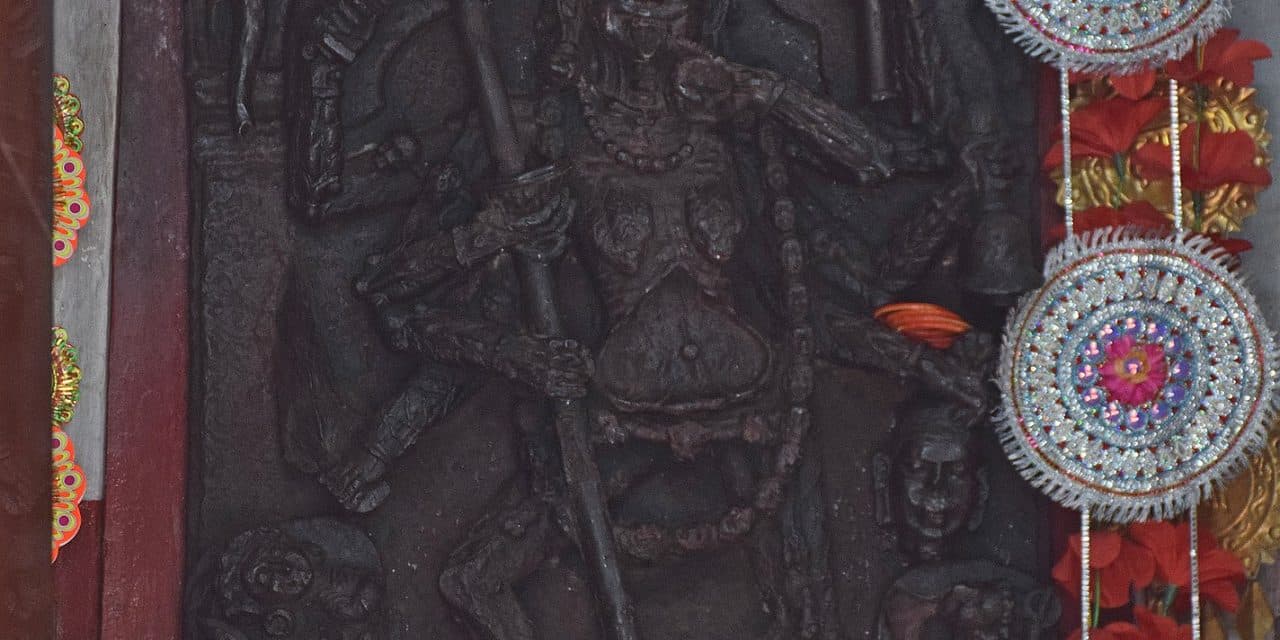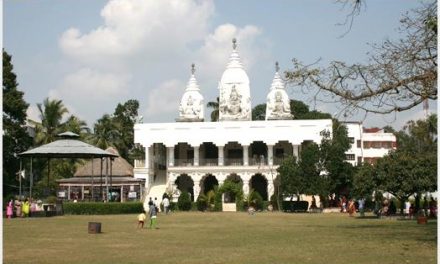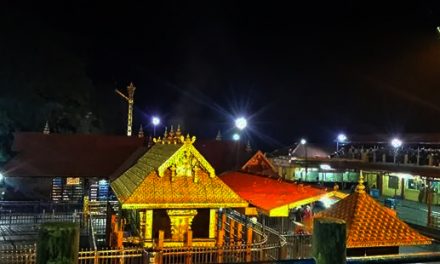A fearsome impersonation of Devi Parvati is noted as ‘Kankaleshwari Kali'(Skeleton Kali) in the Puranas. The famous and ancient Kankaleshwari temple is situated about 8 km northeast of ‘Shantiniketan town in Bolpur on the bank of River Kopai on the ‘Bolpur-Labpur Road’. The temple has been characterised by its nine peaks and got its identity as the ‘Navaratna(Nine gems) Temple’. It is considered as one of the fifty-one Shakti Peethas where Devi Parvati’s(alias Devi Sati’s) bones(waist) fell during the ‘tandava'(rampage) of Lord Shiva(beloved husband of Devi Parvati) carrying Her corpsed on His shoulders was dismembered by Lord Vishnu with His ‘Sudarshana Chakra'(Disc of auspicious vision). From the faraway, this temple is famed also with its name ‘Kamakshi Shaktipeeth’ or ‘Kankaleshwari Devi temple’ where the locals have their affection for this temple by the name ‘Kankal Bari(House of the skeleton) alias ‘Rakta Tola'(Blood-Temple).
About the emergence of the idol as well as the establishment of the temple
This skeleton idol of the temple, which is 250 years old, was found in 1700 AD, constructed by the Panchkot Raj, and believed by the archaeologists and other experts to be the ‘Yakshini’ of the pre-Aryan age. The legend goes that human sacrifices were practised at this temple in the remote part. As per the archaeologists, this idol is contemporary to the Buddha or the Pala era. It may be of the Jain era, according to some experts and influenced by the ‘Buddhist Tantra’. Although the exact historical timing of this idol is not yet ascertained, it is assumed by about 2,000 years old. There is also a controversy about its findings, yet it may be in 1916 or 1923.
Temple premises
At the entrance, a large gate(A tower) is waiting to receive the devotees, and at the right side of the gate, a couple is showing off a farmer or labourer. Crossing two bridges and through the serpentine lanes, a huge open ground seems to be a playground with the temple seen. As we know, it is a Navaratna style of temple architecture that incorporates two primary levels, each with four spired corner pavilions and a central pavilion above for nine spires. This style of temple architecture was introduced in Bengal during the eighteen century as a promotion of the ‘Pancharatna’ style that had five pavilions(four at the corners and one above). The temple stands on a square courtyard with the front decorations of terracotta panels displaying sages, kings, mendicants and family persons. The temple has three adjoining chambers. In the main house, the Kankaleshwari Kali idol is sedentary(on hearsay, there is no idol of a goddess but a great frame photograph of Devi); in the rest two, there are Shivlingas and tridents, respectively.

What the idol looks like?
This sculpture is made of precious stone carved on an integrated black Basalt stone and becomes like the human skeleton in which muscles, bones, veins and arteries are evident. This statue is measured in width by 3 feet and in length by 5 feet. Similarities are seen in many aspects between the Kankaleshwari Kali idol and the iconography of Kamakhya. The Kankaleshwari Kali stands on a Lotus which comes from Shiva’s navel, and the Kamakhya also sits upon a Lotus that origins in Shiva’s navel. Another similarity between the two is that Kamakhya is sedentary, with Brahma and Vishnu to each side of Her. They are also seated upon a Lotus, and Kankaleshwari has two figures on Lotus and a corpse on either side. In the case of Kamakhya, Shiva lies atop a lion, while in Kankaleshwari Kali, Shiva lies on the ground with open eyes and folded palms, paying respect to Her. The Kankaleshwari Kali bears four right hands and also four left hands. Among Her four right hands, She holds the trident in two hands, sword in one hand and a dagger with the rest and alike among Her left four hands, one has an axe, with the second one a bell, with third one a beheaded head of a demon and with the last one’s forefinger hols Her tongue. To depict Her Hair, it comprises of hooded snakes and to tie Her Hair, skulls of birds and beasts are utilised as Her hair band. Her hair band is adorned with a central gem made of a human face. Bones form Her waistband.
How is Mata Kankaleshwari worshipped?
Mata Kankaleshwari Kali has been worshipped at the time of the annual Kali Puja with devotion and enthusiasm for years at this temple complex. Devotees and the visitors eagerly intend to congregate here with their intensity so that the complex becomes unable to allow sesame. At this great festival, almost 20,000 people are blessed to have Mata’s (goddess Kankaleshwari Kali) grace as the shape of the ‘Bhog of Rice’. Being part of this great festival, everyone wants to earn a unique experience. Outstandingly Maa Chamunda’s image is worshipped here as a divine mother and protector of the village. Apart from this fantastic festival, in the Bengali month of ‘Karthik'(from October to November), on every occasion of ‘New Moon,’ a special Puja is held here. For that reason, thousands of people crowd here to witness this ceremony. However, devotees become attracted to this temple throughout the year.
The authority assigns norms and facilities:
This temple opens its door for its pilgrims every day at 6:00 a.m., closes at 2:00 p.m., reopens at 4:00 p.m. and closes for the day at 7:00 p.m. Photography is strictly prohibited inside the temple premises. The authority provides the pilgrims parking facility and facilitates them with a well-maintained temple. Food and drinking water are generally available. Entrance into the temple premises is free for all.
How to reach?
The nearest rail station is Bolpur Railway Station. Bolpur is connected to Kolkata and Howrah Junction by daily trains. Kankaleshwari Kali Temple has situated about 9 km from Bolpur.
Postal Address of Kankaleshwari Kali Temple: Temple Road, near Abasarika Park, Kanchan Nagar, Pin: 713102, West Bengal, India.
Image courtesy: Amitabha Gupta
















